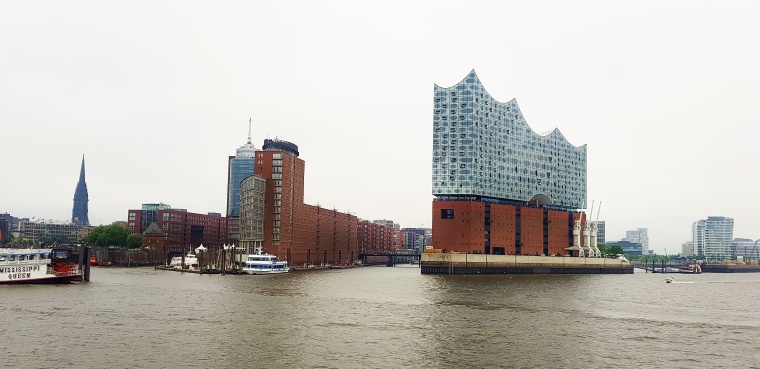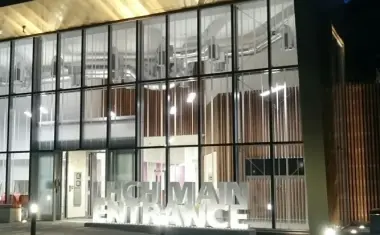Hamburg’s Elbe Philharmonic Hall with Air Sampling Smoke Detectors
A visit to Hamburgs Elbe Philharmonic Hall starts with a little ticket, but not necessarily with a concert ticket. A plaza ticket is enough to visit the Philharmonic Hall, whose of...

A visit to Hamburg’s Elbe Philharmonic Hall starts with a little ticket, but not necessarily with a concert ticket. A plaza ticket is enough to visit the Philharmonic Hall, whose official opening took place in January 2017, some fifteen years and three weeks after the first pen sketch was drawn up. With its 26 floors, the building is like a high-rise apartment – and the routes through it are correspondingly long. This means that the fire protection requirements are huge.
The 360-degree outdoor terrace is freely accessible to visitors, and even the route there is impressive. A more than 80-meter long escalator known as the ‚Tube‘ links the Philharmonic Hall’s ground floor entrance to its visitor deck. This is one of the longest escalators in Western Europe and was specially developed for the concert hall by the Kone company. On arriving at the Plaza, the impressive size of the concert hall becomes apparent for the first time.
Constructed atop the former Kaispeicher A building, built between 1963 and 1966 and used as a warehouse for tea, tobacco and cocoa until the 1990s, the glass, steel and wooden complex towers 110 meters into the air. The view from the outdoor terrace is simply spectacular: sitting on the banks of the Elbe River, the Elbe Philharmonic Hall is surrounded by water on three sides, near seagulls, cruise ships and the harbor. St. Michael’s Church and the Elbe bridges are close by and the Speicherstadt district is but a stone’s throw away. All Hamburg‘s landmarks are grouped together in the surrounding area yet are highly contrasting, just like the concert hall itself that was designed by the renowned Swiss architectural firm Herzog & de Meuron.
Huge Demands on the Fire Protection Solution
This is where the experience ends for normal plaza visitors, however: a concert ticket is the only way to access the concert halls and bar areas above them with their exquisite heavily wood-featured interior designs. But this is not the case for Dennis Just, Technical Manager of the Elbe Philharmonic Hall, whose access card grants him entrance to almost any area of the building – even behind the scenes of the Elbe Philharmonic Hall, where the Wagner Group has installed its fire protection technology.
The Elbe Philharmonic Hall uses an extensive fire protection concept comprising a wide range of systems from various companies. „The building is well and safely constructed, but has an extremely complicated and nested design“, commented 38-year-old Just, who, together with his team of 22 staff, has been responsible for technology in the Elbe Philharmonic Hall and the Laeiszhalle concert hall since 2013. With 26 floors and long routes through the building, the fire protection requirements are huge. Firstly, there are structural fire protection measures such as fire doors that prevent the entire Elbe Philharmonic Hall from having to be evacuated if a fire is detected. After all, in the case of a full house, the building would contain 4,500 visitors – not to mention several hundred employees and musicians. Secondly, the overall concept includes system-based fire protection solutions, and this is where the Wagner Group and its solution come in.
The Titanus Top-Sens air sampling smoke detectors in the Silent version use active fire detection to protect around 40 rooms, including the showpiece: The Great Hall. With its acoustically sophisticated inner shell made of gypsum fiberboards (‘white skin’) and its freely suspended structure within the building, the concert hall is truly unique. „If the Queen Mary toots its horn out on the Elbe, you don’t hear it in the Hall“, Just explained.
Sampling Technology
Titanus units were also installed in the Little Hall, foyer areas and technology areas. „Smoke detection is an extremely important matter for us“, commented the Technical Manager, who was heavily involved in the selection of the fire protection systems during the long project and construction phase. „Air sampling smoke detectors are an ideal solution for the halls. To date, the Wagner Group’s product has worked error-free“, stated Just, who also believes that no longer using point-type detectors in the exquisite foyer areas was „exactly the right decision“. Unlike point-type detectors, the sampling points of the Titanus units can be almost invisibly integrated in walls and ceilings – as per one of the architectural firm’s mandatory stipulations. When speaking to Dennis Just, his passion for fire protection and safety was extremely clear – not only because this is part of his job as Technical Manager, but also because finding the best solution for his areas of responsibility, and therefore also the Elbe Philharmonic Hall, is a matter close to his heart.
Dual Detection
The requirement to use Titanus air sampling smoke detectors for earliest smoke detection resulted from both the structural conditions and the architectural firm’s specifications that the detectors had to be installed almost invisibly. As a result, air sampling smoke detectors were the only viable option for the Great Hall as this has a height of 25 meters. Together with heat sensor cables in the floor of the auditorium, the Titanus units control a high-pressure mist extinguishing system for fire suppression. This means that if the system detects a fire, the extinguishing system’s sprinkler heads are pre-flooded; until then they are dry. If the heat cables also detect a rise in temperature in the room, the extinguishing system triggers.
The high-pressure mist extinguishing system therefore uses a two-fold safety mechanism. After all, damage to the permanently installed organ and the ‘white skin’ responsible for the good acoustics in the hall is inevitable in the case of water contact. As it is not only the Elbe Philharmonic Hall’s structural design that is complex, but also its floor plan and the interlinking systems within the scope of the fire protection concept, the fire brigade responsible for the concert hall has to conduct regular emergency drills. They are assisted by clear maps and information about the exact position of the individual components – in this case even the individual air sampling points of the Titanus system.















